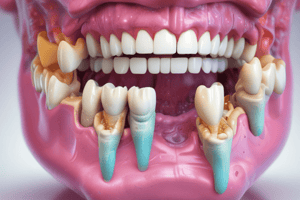Podcast
Questions and Answers
What is the definition of dental caries?
What is the definition of dental caries?
An infectious microbiologic disease of the teeth that results in localized dissolution and destruction of calcified tissues.
Which of the following is a contributing factor in the development of dental caries?
Which of the following is a contributing factor in the development of dental caries?
- Teeth brushing
- Fluoride application
- Sugar consumption (correct)
- Regular dental check-ups
A caries diagnosis involves the clinical judgement integrating available information, including the detection and assessment of caries signs (lesions) to determine the presence of the disease, which is called _____.
A caries diagnosis involves the clinical judgement integrating available information, including the detection and assessment of caries signs (lesions) to determine the presence of the disease, which is called _____.
diagnosis
What does 'caries free' imply?
What does 'caries free' imply?
What are cariogenic substances?
What are cariogenic substances?
Cavitated lesions denote a loss of surface integrity.
Cavitated lesions denote a loss of surface integrity.
What was the earliest theory regarding the cause of dental caries?
What was the earliest theory regarding the cause of dental caries?
Who first proclaimed that disease was due to natural causes?
Who first proclaimed that disease was due to natural causes?
The clinically observable manifestations of caries disease are referred to as _____.
The clinically observable manifestations of caries disease are referred to as _____.
Flashcards are hidden until you start studying
Study Notes
Introduction to Cariology
- Dental caries is defined as an infectious disease leading to localized dissolution and destruction of teeth.
- Two primary definitions emphasize tooth decay due to microbiological factors and acid production from biofilms interacting with sugars.
Terminology
- Caries Diagnosis involves clinical assessment of lesions to confirm the presence of the disease.
- Caries Activity indicates the mineral balance in terms of loss, gain, or stasis over time.
- Active Caries signifies ongoing caries initiation and progression.
- Inactive Caries reflects halted caries development or regression.
- Prognosis of Caries predicts the expected course of the disease.
- Caries Free means no detectable carious signs; Cavity Free indicates no detected cavities in dentine, although non-cavitated lesions may exist.
- Caries Management encompasses strategies to interfere with mineral loss throughout the caries progression.
- Non-operative treatments include topical fluoride applications.
- Operative treatments involve restoration through removing affected tooth portions.
- Caries Prevention aims to inhibit caries initiation through integrated treatment approaches.
- Cariogenic substances, like sugars, promote caries development.
- Cariostatic substances, such as fluoride, can inhibit caries progression.
- Dental Biofilm consists of microorganisms and materials adhering to tooth surfaces, whereas dental plaque is the clinical term for this biofilm.
- Caries Lesion refers to the clinical manifestation of dental caries, which can be Non-cavitated (initial stages with no cavitation) or Cavitated (where surface integrity is lost and dentin is exposed).
History of Dental Caries
- Evidence of dental caries dates back millions of years, with skeletal remains showing signs in ancient fish, dinosaurs, and prehistoric mammals.
- Ancient records from Sumeria (5000 BC) and the “tooth worm” concept attributed to the causes of caries were noted in Chinese texts from 2500 BC.
- Hippocrates (460–357 BC) recognized natural causes for diseases, while Aristotle (350 BC) identified sweets as contributors to tooth decay.
- Caries prevalence was low during the Bronze and Iron Ages, but saw a notable increase with the introduction of sugar cane in the 11th century.
- By the Middle Ages, around 20% of teeth were affected by caries, especially among populations consuming cooked foods.
Studying That Suits You
Use AI to generate personalized quizzes and flashcards to suit your learning preferences.




